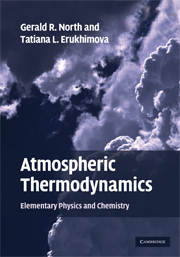Book contents
- Frontmatter
- Contents
- Preface
- 1 Introductory concepts
- 2 Gases
- 3 The First Law of Thermodynamics
- 4 The Second Law of Thermodynamics
- 5 Air and water
- 6 Profiles of the atmosphere
- 7 Thermodynamic charts
- 8 Thermochemistry
- 9 The thermodynamic equation
- Appendix A Units and numerical values of constants
- Appendix B Notation and abbreviations
- Appendix C Answers for selected problems
- Bibliography
- Index
1 - Introductory concepts
Published online by Cambridge University Press: 01 February 2010
- Frontmatter
- Contents
- Preface
- 1 Introductory concepts
- 2 Gases
- 3 The First Law of Thermodynamics
- 4 The Second Law of Thermodynamics
- 5 Air and water
- 6 Profiles of the atmosphere
- 7 Thermodynamic charts
- 8 Thermochemistry
- 9 The thermodynamic equation
- Appendix A Units and numerical values of constants
- Appendix B Notation and abbreviations
- Appendix C Answers for selected problems
- Bibliography
- Index
Summary
The atmosphere is a compressible fluid, and the description of such a form of matter is usually unfamiliar to students who are just completing calculus and classical mechanics as part of a standard university physics course. To complicate matters the atmosphere is composed of not just a single ingredient, but several ingredients, including different (mostly nonreactive) gases and particles in suspension (aerosols). Some of the ingredients change phase (primarily water) and there is an accompanying exchange of energy with the environment. The atmosphere also interacts with its lower boundary which acts as a source (and sink) of friction, thermal energy, water vapor, and various chemical species. Electromagnetic radiation enters and leaves the atmosphere and in so doing it warms and cools layers of air, interacting selectively with different constituents in different wavelength bands.
Meteorology is concerned with describing the present state of the atmosphere (temperature, pressure, winds, humidity, precipitation, cloud cover, etc.) and in predicting the evolution of these primary variables over time intervals of a few days. The broader field of atmospheric science is concerned with additional themes such as climate (statistical summaries of weather), air chemistry (its present, future, and history), atmospheric electricity, atmospheric optics (across all wavelengths), aerosols and cloud physics. Both the present state of the bulk atmosphere and its evolution are determined by Newton's laws of mechanics as they apply to such a compressible fluid. Dynamics is concerned primarily with the motion of the atmosphere under the influence of various natural forces. But before one can undertake the study of atmospheric dynamics, one must be able to describe the atmosphere in terms of its primary variables.
- Type
- Chapter
- Information
- Atmospheric ThermodynamicsElementary Physics and Chemistry, pp. 1 - 19Publisher: Cambridge University PressPrint publication year: 2009



